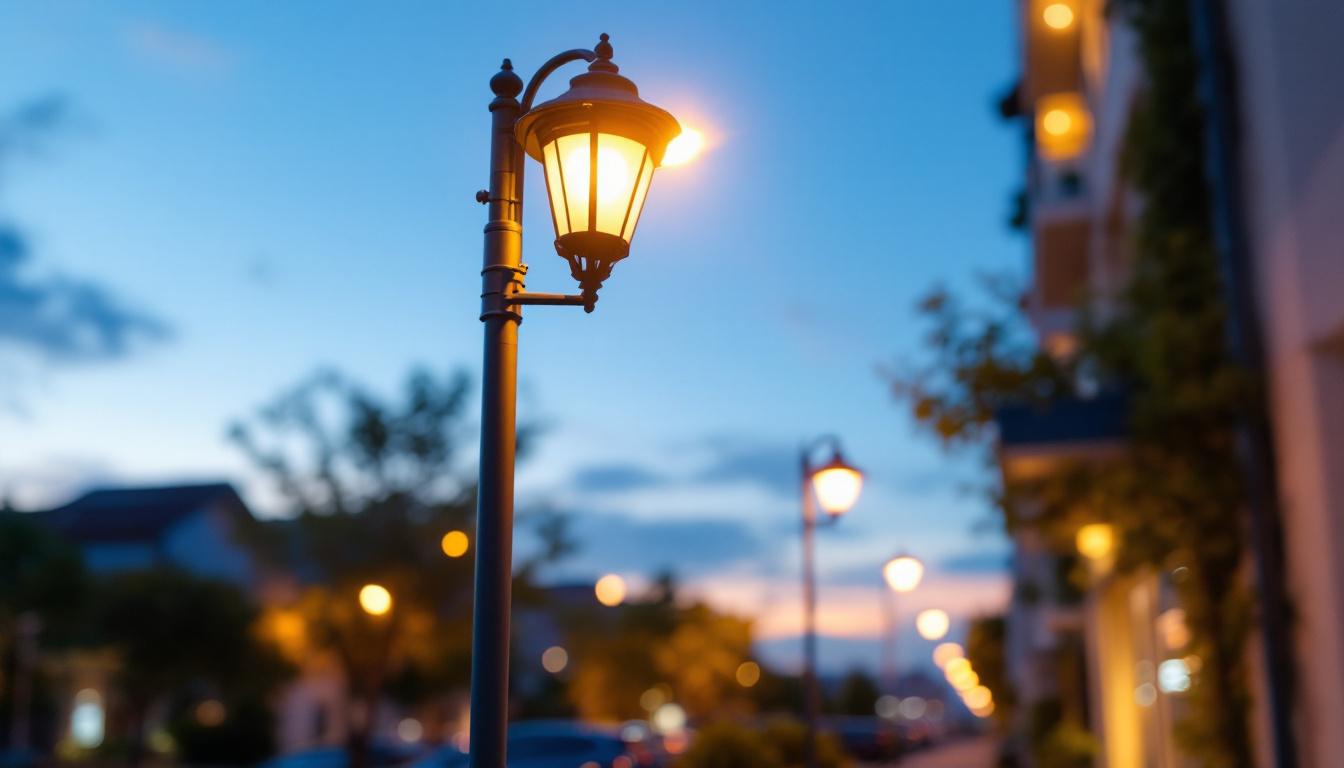
In the world of outdoor lighting, the exterior light pole plays a crucial role in enhancing visibility, safety, and aesthetics. For lighting contractors, understanding the nuances of light pole selection, installation, and maintenance is essential for delivering quality projects. This article delves into the key considerations that lighting contractors should keep in mind when working with exterior light poles.
When it comes to exterior light poles, there are several types available, each suited for different applications. Familiarity with these types can help contractors make informed decisions that meet their clients’ needs.
Light poles are typically made from materials such as aluminum, steel, fiberglass, or concrete. Aluminum poles are lightweight and resistant to corrosion, making them ideal for coastal areas. Steel poles, while heavier, offer strength and durability, which is beneficial in high-wind regions. Fiberglass poles are non-corrosive and can be molded into various shapes, providing versatility in design. Concrete poles, though less common, are incredibly durable and can withstand severe weather conditions. Additionally, the choice of material can also impact maintenance costs; for instance, aluminum poles may require less upkeep over time compared to steel, which may need periodic painting to prevent rusting. Understanding these nuances can help contractors provide more accurate estimates and recommendations to their clients.
The height of a light pole significantly affects the distribution of light. Generally, taller poles are used for larger areas, such as parking lots or sports fields, while shorter poles are suitable for sidewalks and pathways. Contractors should consider the specific lighting requirements of the project, including the desired illumination level and the spacing between poles, to determine the appropriate height. Moreover, the height can also influence safety and security; for example, taller poles can help eliminate dark spots that may pose risks in public areas. In some cases, adjustable height poles are available, allowing for flexibility in lighting configurations as needs change over time.
Beyond functionality, the design of light poles can enhance the visual appeal of an outdoor space. Many municipalities and businesses prefer decorative poles that complement architectural styles or landscaping. Contractors should be aware of the various design options available, from classic lantern-style poles to sleek modern designs, to meet the aesthetic preferences of their clients. Furthermore, the integration of smart technology into light pole designs is becoming increasingly popular, with options for LED lighting, solar panels, and even Wi-Fi hotspots. These innovations not only improve energy efficiency but also contribute to the overall ambiance of the area, making it more inviting and functional for users. As such, contractors must stay informed about the latest trends in light pole design to provide clients with cutting-edge solutions that enhance both beauty and utility.
With advancements in lighting technology, contractors must stay informed about the latest options available for outdoor lighting. This knowledge can help them recommend the best solutions for their clients’ needs. As outdoor spaces become increasingly utilized for entertainment and leisure, the importance of effective lighting solutions cannot be overstated. From enhancing safety to creating ambiance, the right lighting can transform a simple backyard into a stunning outdoor retreat.
LED lighting has rapidly gained popularity due to its energy efficiency and long lifespan. Unlike traditional incandescent or halogen bulbs, LEDs consume significantly less energy and require less frequent replacements. This not only reduces operational costs but also minimizes maintenance efforts for clients. Furthermore, LEDs are available in a variety of color temperatures, allowing contractors to customize the lighting to suit the mood and function of the outdoor space. Contractors should educate their clients about the benefits of LED lighting and help them transition to this modern solution. By highlighting the environmental benefits, such as reduced carbon footprint and lower waste generation, contractors can appeal to eco-conscious clients who are looking to make sustainable choices.
Smart lighting technology is transforming the way outdoor spaces are illuminated. Features such as motion sensors, dimming capabilities, and remote control options enhance both functionality and energy efficiency. With the advent of smart home systems, outdoor lighting can now be synchronized with other elements of the home, creating a cohesive and convenient user experience. Contractors should consider integrating smart technology into their lighting designs, allowing clients to have greater control over their outdoor lighting systems. This can lead to increased satisfaction and long-term savings. Additionally, smart lighting can be programmed to adjust based on time of day or occupancy, further optimizing energy use and enhancing security by ensuring that pathways and entry points are well-lit when needed.
The installation process of exterior light poles is critical to ensuring their longevity and effectiveness. Proper techniques and adherence to safety standards can prevent future issues and enhance the overall quality of the project.
Before installation, conducting a thorough site assessment is essential. This includes evaluating the terrain, existing infrastructure, and potential obstacles that may affect light pole placement. Understanding the site conditions will help contractors determine the best locations for poles to maximize light coverage and minimize shadows. Additionally, factors such as the proximity to trees, buildings, and other structures should be taken into account, as they can obstruct light and create unwanted dark spots. Analyzing the surrounding environment also allows for consideration of aesthetic factors, ensuring that the light poles complement the overall landscape design.
A solid foundation is vital for the stability of light poles. Depending on the pole’s height and material, contractors may need to dig a hole and pour concrete to secure the base. It’s important to follow manufacturer guidelines regarding the depth and width of the foundation to ensure the pole can withstand wind loads and other environmental factors. Moreover, the use of gravel or other drainage materials at the base can help prevent water accumulation, which could lead to erosion or instability over time. Regular inspections of the foundation after installation can also help identify any potential issues early, allowing for timely maintenance and repairs.
Proper electrical connections are crucial for the safe operation of outdoor lighting. Contractors should ensure that all wiring is weatherproof and compliant with local electrical codes. Additionally, implementing surge protection can safeguard the lighting system from voltage spikes, prolonging its lifespan and reducing maintenance costs. It is also advisable to use energy-efficient LED fixtures, which not only consume less power but also produce less heat, further enhancing safety. Furthermore, incorporating smart technology, such as timers or motion sensors, can optimize energy use and provide flexibility in lighting control, adapting to varying needs throughout the day and night.
Regular maintenance is key to ensuring that exterior light poles function effectively over time. Contractors should provide clients with clear guidelines on how to care for their lighting systems.
Conducting routine inspections can help identify potential issues before they escalate. Contractors should recommend checking for signs of corrosion, loose fittings, and damaged wiring. Regular cleaning of the poles and fixtures will also help maintain optimal light output and prevent dirt buildup that can hinder performance.
Lighting contractors should be prepared to troubleshoot common issues that may arise with exterior light poles. This includes flickering lights, which may indicate a loose connection, or lights that fail to turn on, which could be due to a blown fuse or faulty wiring. Providing clients with a basic understanding of these issues can empower them to seek assistance promptly when problems occur.
Compliance with local regulations and safety standards is paramount in the installation of exterior light poles. Contractors must be aware of the requirements that govern outdoor lighting to avoid potential legal issues.
Before beginning a project, contractors should familiarize themselves with local zoning laws that may dictate the height, brightness, and placement of light poles. Some municipalities have specific guidelines to minimize light pollution and ensure that outdoor lighting does not interfere with neighboring properties. Understanding these regulations can help contractors avoid costly fines and project delays.
Adhering to safety standards is essential for protecting both workers and the public. Contractors should follow guidelines set forth by organizations such as the National Electrical Code (NEC) and Occupational Safety and Health Administration (OSHA). This includes proper grounding of poles, ensuring safe access during installation, and using appropriate personal protective equipment (PPE) during the installation process.
Effective communication with clients is vital for ensuring successful project outcomes. Lighting contractors should prioritize educating their clients about the various aspects of exterior light poles.
From the outset, contractors should set clear expectations regarding project timelines, costs, and potential challenges. This transparency fosters trust and helps clients feel more informed and involved in the decision-making process. Providing detailed proposals that outline the scope of work can also help prevent misunderstandings later on.
After the installation is complete, contractors should remain available for support and questions. Offering a warranty on the installation can provide clients with peace of mind and encourage them to reach out for assistance if issues arise. Regular follow-up communication can also help contractors stay connected with clients and build long-term relationships.
Exterior light poles are a fundamental component of outdoor lighting systems, and lighting contractors play a pivotal role in their selection, installation, and maintenance. By understanding the various types of light poles, staying informed about lighting technology, adhering to best practices during installation, and maintaining open communication with clients, contractors can ensure successful projects that meet the needs of their clients. As the demand for effective outdoor lighting continues to grow, being knowledgeable about these key points will position contractors as trusted experts in the field.
Ready to elevate your lighting projects with the highest quality poles and fixtures? At LumenWholesale, we provide lighting contractors like you with spec-grade lighting products at unbeatable wholesale prices. Say goodbye to local distributor markups and hello to superior lighting solutions that meet the highest industry standards. With our hassle-free bulk buying process, free shipping, and commitment to quality and affordability, you can trust LumenWholesale to light up your projects with reliability and style. Don’t compromise on your lighting needs—discover the best value in wholesale lighting today and make your outdoor lighting projects shine.

Discover essential tips and common pitfalls for lighting contractors when installing pendant lighting.

Discover the ultimate guide to LED light tubes with our essential checklist tailored for lighting professionals.

Discover the essential role of ballasts in lighting systems with our comprehensive guide tailored for lighting contractors.

Discover the insider tips and expert strategies that lighting contractors use to transform spaces with precision and creativity.